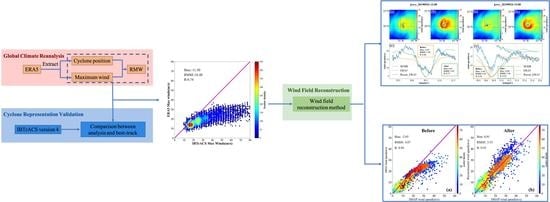Tropical Cyclone Wind Field Reconstruction and Validation Using Measurements from SFMR and SMAP Radiometer
Abstract
:1. Introduction
2. Materials and Methods
2.1. ERA5
2.2. IBTrACS
2.3. SFMR
2.4. Methodology
- (1)
- The tropical cyclone must be named in IBTrACS; “Not_named” cyclones are ignored.
- (2)
- All invalid values are ignored in the tropical cyclone position of longitude and latitude, maximum sustained wind speed and RMW variables provided by IBTrACS.
- (3)
- The intensity level of tropical cyclones provided by IBTrACS should be higher than Tropical Depression.
2.5. Evaluation Metrics
3. Results
3.1. Validation and Uncertainty Estimate
3.1.1. Position Uncertainty
3.1.2. Comparison of Maximum Wind Speed between IBTrACS and ERA5
3.2. Wind Fields Reconstructed by Proposed Method
3.3. Validation of Wind Fields between SFMR and Reconstruction
3.4. Validation of Wind Fields between SMAP and Reconstruction
4. Discussion
5. Conclusions
Author Contributions
Funding
Data Availability Statement
Acknowledgments
Conflicts of Interest
References
- Price, J.F. Upper Ocean Response to a Hurricane. J. Phys. Oceanogr. 1981, 11, 153–175. [Google Scholar] [CrossRef]
- Hodges, K.; Cobb, A.; Vidale, P.L. How Well are Tropical Cyclones Represented in Reanalysis Datasets? J. Climate 2017, 30, 5243–5264. [Google Scholar] [CrossRef]
- Liu, Y.; Weisberg, R.H.; Zheng, L. Impacts of Hurricane Irma on the Circulation and Transport in Florida Bay and the Charlotte Harbor Estuary. Estuar. Coast. 2020, 43, 1194–1216. [Google Scholar] [CrossRef]
- Zhang, H.; Liu, X.; Wu, R.; Chen, D.; Zhang, W. Sea Surface Current Response Patterns to Tropical Cyclones. J. Mar. Sys. 2020, 208, 103345. [Google Scholar] [CrossRef]
- Sheikh, P.A. The Impact of Hurricane Katrina on Biological Resources; Technical Report; Congressional Research Service Report to Congress, RL33117; The Library of Congress: Washington, DC, USA, 2005. [Google Scholar]
- Knabb, R.D.; Rhome, J.R.; Brown, D.P. Tropical Cyclone Report: Hurricane Katrina, August 23–30, 2005. Fire Eng. 2006, 42, 1–42. [Google Scholar]
- Fritz, H.M.; Blount, C.; Sokoloski, R.; Singleton, J.; Fuggle, A.; Mcadoo, B.G.; Moore, A.; Grass, C.; Tate, B. Hurricane Katrina Storm Surge Reconnaissance. J. Geotech. Geoenviron. Eng. 2008, 134, 644–656. [Google Scholar] [CrossRef]
- Adeola, F.O.; Picou, J.S. Social Capital and the Mental Health Impacts of Hurricane Katrina: Assessing Long-Term Patterns of Psychosocial Distress. Int. J. Mass Emerg. Disasters. 2014, 32, 121–156. [Google Scholar]
- Yang, W.; Yin, B.; Feng, X.; Yang, D.; Gao, G.; Chen, H. The Effect of Nonlinear Factors on Tide-Surge Interaction: A Case Study of Typhoon Rammasun in Tieshan Bay, China. Estuar. Coast. Shelf Sci. 2019, 219, 420–428. [Google Scholar] [CrossRef]
- Kang, K.; Kim, D. Retrieval of Sea Surface Velocity during Tropical Cycnes from RADARSAT-1 ScanSAR Doppler Centroid Measurements. In Proceedings of the 2015 IEEE 5th Asia-Pacific Conference on Synthetic Aperture Radar (APSAR), Singapore, 1–4 September 2015; pp. 610–613. [Google Scholar] [CrossRef]
- Mo, D.; Hou, Y.; Li, J.; Liu, Y. Study on the storm surges induced by cold waves in the Northern East China Sea. J. Mar. Sys. 2016, 160, 26–39. [Google Scholar] [CrossRef]
- Maloney, E.; Hartmann, D. Modulation of Hurricane activity in the Gulf of Mexico by the Madden-Julian Oscillation. Science 2000, 287, 2002–2004. [Google Scholar] [CrossRef]
- Maloney, E.D.; Hartmann, D.L. Modulation of Eastern North Pacific Hurricanes by the Madden-Julian Oscillation. J. Climate 2000, 13, 1451–1460. [Google Scholar] [CrossRef]
- Schenkel, B.A.; Hart, R.E. An Examination of Tropical Cyclone Position, Intensity, and Intensity Life Cycle within Atmospheric Reanalysis Datasets. J. Climate 2012, 25, 3453–3475. [Google Scholar] [CrossRef]
- Thorne, P.W.; Vose, R.S. Reanalyses Suitable for Characterizing Long-Term Trends. Bull. Am. Meteorol. Soc. 2010, 91, 353–361. [Google Scholar] [CrossRef]
- Saha, S.; Moorthi, S.; Wu, X.; Wang, J.; Nadiga, S.; Tripp, P.; Behringer, D.; Hou, Y.T.; Chuang, H.Y.; Iredell, M.; et al. The NCEP Climate Forecast System Version 2. J. Climate 2012, 27, 2185–2208. [Google Scholar] [CrossRef]
- Hersbach, H.; Bell, B.; Berrisford, P.; Hirahara, S.; Horányi, A.; Muñoz-Sabater, J.; Nicolas, J.; Peubey, C.; Radu, R.; Schepers, D.; et al. The ERA5 Global Reanalysis. Q. J. R. Meteorolog. Soc. 2020, 146, 1999–2049. [Google Scholar] [CrossRef]
- Gelaro, R.; Mccarty, W.; Suárez, M.; Todling, R.; Zhao, B. The Modern-Era Retrospective Analysis for Research and Applications, Version 2 (MERRA-2). J. Climate 2017, 30, 5419–5454. [Google Scholar] [CrossRef]
- Kazutoshi, O.; Kamahori, H.; Ota, Y.; Takahashi, K.; Harada, Y. The JRA-55 Reanalysis: General Specifications and Basic Characteristics. J. Meteorol. Soc. Jpn. 2015, 93, 5–48. [Google Scholar] [CrossRef]
- Liu, Z.Q.; Shi, C.X.; Zhou, Z.J. CMA Global Reanalysis (CRA-40): Status and Plans. In Proceedings of the International Conference on Reanalysis, Rome, Italy, 13–17 September 2017. [Google Scholar]
- Jourdain, N.C.; Barnier, B.; Ferry, N.; Vialard, J.; Menkes, C.E.; Lengaigne, M.; Parent, L. Tropical Cyclones in Two Atmospheric (Re)Analyses and Their Response in Two Oceanic Reanalyses. Ocean Model. 2014, 73, 108–122. [Google Scholar] [CrossRef]
- Scardino, G.; Scicchitano, G.; Chirivì, M.; Costa, P.J.M.; Luparelli, A.; Mastronuzzi, G. Convolutional Neural Network and Optical Flow for the Assessment of Wave and Tide Parameters from Video Analysis (LEUCOTEA): An Innovative Tool for Coastal Monitoring. Remote Sens. 2022, 14, 2994. [Google Scholar] [CrossRef]
- Hatsushika, H.; Tsutsui, J.; Onogi, K.; Fiorino, M. Impact of Wind Profile Retrievals on the Analysis of Tropical Cyclones in the JRA-25 Reanalysis. J. Meteorol. Soc. Jpn. 2006, 84, 891–905. [Google Scholar] [CrossRef]
- Kazutoshi, O.; Junichi, T.; Hiroshi, K.; Masami, S.; Shinya, K.; Hiroaki, H.; Takanori, M.; Nobuo, Y.; Hirotaka, K.; Kiyotoshi, T. The JRA-25 Reanalysis. J. Meteorol. Soc. Jpn. 2007, 85, 369–432. [Google Scholar] [CrossRef]
- Roth, D.M. A Fifty Year History of Subtropical Cyclones. In Proceedings of the 5th Conference on Hurricanes and Tropical Meteorology, San Diego, CA, USA, 29 April–3 May 2002; p. 43. [Google Scholar]
- Guishard, M.P.; Evans, J.L.; Hart, R.E. Atlantic Subtropical Storms. Part II: Climatology. J. Climate 2009, 22, 3574–3594. [Google Scholar] [CrossRef]
- Truchelut, R.E.; Hart, R.E. Quantifying the Possible Existence of Undocumented Atlantic Warm-core Cyclones in NOAA/CIRES 20th Century Reanalysis Data. Geophys. Res. Lett. 2011, 38, L08811. [Google Scholar] [CrossRef]
- Kim, H.; Lee, M.I.; Kim, S.; Lim, Y.K.; Schubert, S.D.; Molod, A.M. Representation of Tropical Cyclones by the Modern-Era Retrospective Analysis for Research and Applications Version 2. Asia-Pac. J. Atmos. Sci. 2021, 57, 35–49. [Google Scholar] [CrossRef]
- Aryal, Y.; Villarini, G.; Zhang, W.; Vecchi, G. Long term changes in flooding and heavy rainfall associated with North Atlantic tropical cyclones: Roles of the North Atlantic Oscillation and El Niño-Southern Oscillation. J. Hydrol. 2018, 559, 698–710. [Google Scholar] [CrossRef]
- Villarini, G.; Zhang, W.; Miller, P.; Johnson, D.; Grimley, L.; Roberts, H. Probabilistic rainfall generator for tropical cyclones affecting Louisiana. Int. J. Climatol. 2021, 42, 1789–1802. [Google Scholar] [CrossRef]
- Wang, H.; Ting, M. Seasonal Cycle of the Climatological Stationary Waves in the NCEP–NCAR Reanalysis. J. Atmospheric Sci. 1999, 56, 3892–3919. [Google Scholar] [CrossRef]
- Brooks, H.E.; Anderson, A.R.; Riemann, K.; Ebbers, I.; Flachs, H. Climatological Aspects of Convective Parameters from the NCAR/NCEP Reanalysis. Atmos. Res. 2007, 83, 294–305. [Google Scholar] [CrossRef]
- Decker, M.; Brunke, M.A.; Wang, Z.; Sakaguchi, K.; Zeng, X.; Bosilovich, M.G. Evaluation of the Reanalysis Products from GSFC, NCEP, and ECMWF Using Flux Tower Observations. J. Climate 2010, 25, 1916–1944. [Google Scholar] [CrossRef]
- Moalafhi, D.B.; Evans, J.P.; Sharma, A. Evaluating Global Reanalysis Datasets for Provision of Boundary Conditions in Regional Climate Modelling. Clim. Dyn. 2016, 47, 2727–2745. [Google Scholar] [CrossRef]
- Vishnu, S.; Sanjay, J.; Krishnan, R. Assessment of Climatological Tropical Cyclone Activity Over the North Indian Ocean in the Cordex-south Asia Regional Climate Models. Clim. Dyn. 2019, 53, 5101–5118. [Google Scholar] [CrossRef]
- Bengtsson, L.; Hodges, K.I.; Esch, M. Tropical Cyclones in A T159 Resolution Global Climate Model: Comparison with Observations and Re-Analyses. Tellus. 2007, 59, 396–416. [Google Scholar] [CrossRef]
- Karl, H.; Chalonge, L.; Reghezza, M.; Augendre, M. The Reanalysis of the Tropical Cyclones Intensity in the South Pacific during the 1982–1983 El Nino. In Proceedings of the 28th Conference on Hurricanes and Tropical Meteorology, Orlando, FL, USA, 28 April–2 May 2008. [Google Scholar]
- Larow, T. An Analysis of Tropical Cyclones Impacting the Southeast United States from a Regional Reanalysis. Reg. Environ. Chang. 2013, 13, S35–S43. [Google Scholar] [CrossRef]
- Ridder, N.; Vries, H.D.; Drijfhout, S.; Henk, V.; Meijgaard, E.V.; Vries, H.D. Extreme Storm Surge Modelling in the North Sea. Ocean Dyn. 2018, 68, 255–272. [Google Scholar] [CrossRef]
- Dullaart, J.; Muis, S.; Bloemendaal, N.; Aerts, J. Advancing Global Storm Surge Modelling Using the New ERA5 Climate Reanalysis. Clim. Dyn. 2020, 54, 1007–1021. [Google Scholar] [CrossRef]
- Glahn, B.; Taylor, A.; Kurkowski, N.; Shaffer, W.A. The Role of the SLOSH Model in National Weather Service Storm Surge Forecasting. Natl. Wea. Dig. 2009, 33, 3–14. [Google Scholar]
- Greenslade, G.D.; Taylor, A.; Freeman, J.; Sims, H.; Schulz, E.; Colberg, F.; Divakaran, P.; Velic, M.; Kepert, J. A First Generation Dynamical Tropical Cyclone Storm Surge Forecast System Part 1: Hydrodynamic Model; Resreport, Bureau Research Reports; Australian Bureau of Meteorology: Melbourne, Australian, 2018. [Google Scholar]
- Holland, G.J. An Analytic Model of the Wind and Pressure Profiles in Hurricanes. Mon. Weather Rev. 1980, 108, 1212–1218. [Google Scholar] [CrossRef]
- Gao, J.; Luettich, R.; Fleming, J. Development Andinitial Evaluation of a Generalized Asymmetric Tropical Cyclonevortex Model in ADCIRC. In Proceedings of the ADCIRC Users Group Meeting, Ortley Beach, NJ, USA, 29–30 April 2013; Volume 16. [Google Scholar]
- Willoughby, H.E.; Rahn, M.E. Parametric Representation of the Primary Hurricane Vortex. Part I: Observations and Evaluation of the Holland (1980) Model. Mon. Weather Rev. 2004, 134, 1102–1120. [Google Scholar] [CrossRef]
- Ueno, T. Numerical Computations of the Storm Surges in Tosa Bay. J. Oceanogr. Soc. Jpn. 1981, 37, 61–73. [Google Scholar] [CrossRef]
- Powell, M.D.; Houston, S.H.; Amat, L.R.; MorisseauLeroy, N. The HRD Real-time Hurricane Wind Analysis System. J. Wind Eng. Ind. Aerodyn. 1998, 77–78, 53–64. [Google Scholar] [CrossRef]
- Bricheno, L.M.; Soret, A.; Wolf, J.; Jorba, O.; Baldasano, J.M. Effect of High-Resolution Meteorological Forcing on Nearshore Wave and Current Model Performance. J. Atmos. Ocean Tech. 2013, 30, 1021–1037. [Google Scholar] [CrossRef]
- Li, X.; Han, G.; Yang, J.; Chen, D.; Zheng, G.; Chen, N. Using Satellite Altimetry to Calibrate the Simulation of Typhoon Seth Storm Surge off Southeast China. Remote Sens. 2018, 10, 657. [Google Scholar] [CrossRef]
- Li, X.; Yang, D.; Han, G.; Yang, L.; Wang, J.; Yang, J.; Chen, D.; Zheng, G. Exploiting the Potential of Coastal GNSS-R for Improving Storm Surge Modeling. IEEE Geosci. Remote. Sens. Lett. 2021, 18, 1134–1138. [Google Scholar] [CrossRef]
- Knapp, K.R.; Kruk, M.C.; Levinson, D.H.; Diamond, H.J.; Neumann, C.J. The International Best Track Archive for Climate Stewardship (IBTrACS). Bull. Am. Meteorol. Soc. 2010, 91, 363–376. [Google Scholar] [CrossRef]
- Knapp, K.; Diamond, H.; Kossin, J.; Kruk, M.; Schreck, C. International Best Track Archive for Climate Stewardship (IBTrACS) Project, Version 4; NOAA National Centers for Environmental Information: Boulder, CO, USA, 2018. [Google Scholar] [CrossRef]
- Uhlhorn, E.W.; Black, P.G.; Franklin, J.L.; Goodberlet, M.; Carswell, J.; Goldstein, A.S. Hurricane Surface Wind Measurements from an Operational Stepped Frequency Microwave Radiometer. Mon. Weather Rev. 2007, 135, 3070–3085. [Google Scholar] [CrossRef]
- Gao, Y.; Sun, J.; Zhang, J.; Guan, C. Extreme Wind Speeds Retrieval Using Sentinel-1 IW Mode SAR Data. Remote Sens. 2021, 13, 1867. [Google Scholar] [CrossRef]
- Swift, C.; DeHority, D.; Black, P.G.; Chien, J.Z. Microwaveremotesensing of Ocean Surface Wind Speedand Rain Ratesover Tropical Storms. In Proceedings of the URSI Commission F Symposium and Workshop; Frontiers of Remote Sensing of the Oceans and Troposphere from Air and Space Platforms: Shoresh, Israel, 1984; pp. 281–286. [Google Scholar]
- Klotz, B.W.; Uhlhorn, E.W. Improved Stepped Frequency Microwave Radiometer Tropical Cyclone Surface Winds in Heavy Precipitation. J. Atmos. Ocean Tech. 2014, 31, 2392–2408. [Google Scholar] [CrossRef]
- Said, F.; Long, D. Effectiveness Of QuikSCAT’s Ultra-High Resolution Images in Determining Tropical Cyclone Eye Location. In Proceedings of the 2008 IEEE International Geoscience and Remote Sensing Symposium, Boston, MA, USA, 8–11 July 2008. [Google Scholar] [CrossRef]
- Irish, J.L.; Resio, D.T.; Ratcliff, J.J. The Influence of Storm Size on Hurricane Surge. J. Phys. Oceanogr. 2008, 38, 2003–2013. [Google Scholar] [CrossRef]
- Meissner, T.F.; Ricciardulli, L. Ocean Vector Winds in Storms from the SMAP L-Band Radiometer; Technical Report; International Meeting of Measuring High Wind Speeds Over the Ocean: Exeter, UK, 2016. [Google Scholar]
- Ricciardulli, L.; Mears, C.; Manaster, A.; Meissner, T. Assessment of CYGNSS Wind Speed Retrievals in Tropical Cyclones. Remote Sens. 2021, 13, 5110. [Google Scholar] [CrossRef]
- Manaster, A.; Ricciardulli, L.; Meissner, T. Tropical Cyclone Winds from WindSat, AMSR2, and SMAP: Comparison with the HWRF Model. Remote Sens. 2021, 13, 2347. [Google Scholar] [CrossRef]
- Zehnder, J.A. The Influence of Large-scale Topography on Barotropic Vortex Motion. J. Atmos. Sci. 1993, 50, 2519–2532. [Google Scholar] [CrossRef]
- Portmann, R.; González-Alemán, J.; Sprenger, M.; Wernli, H. How an uncertain short-wave perturbation on the North Atlantic wave guide affects the forecast of an intense Mediterranean cyclone (Medicane Zorbas). Weather. Clim. Dyn. 2020, 1, 597–615. [Google Scholar] [CrossRef]
- Scicchitano, G.; Scardino, G.; Monaco, C.; Piscitelli, A.; Milella, M.; De Giosa, F.; Mastronuzzi, G. Comparing Impact Effects of Common Storms and Medicanes along the Coast of South-eastern Sicily. Mar. Geol. 2021, 439, 106556. [Google Scholar] [CrossRef]

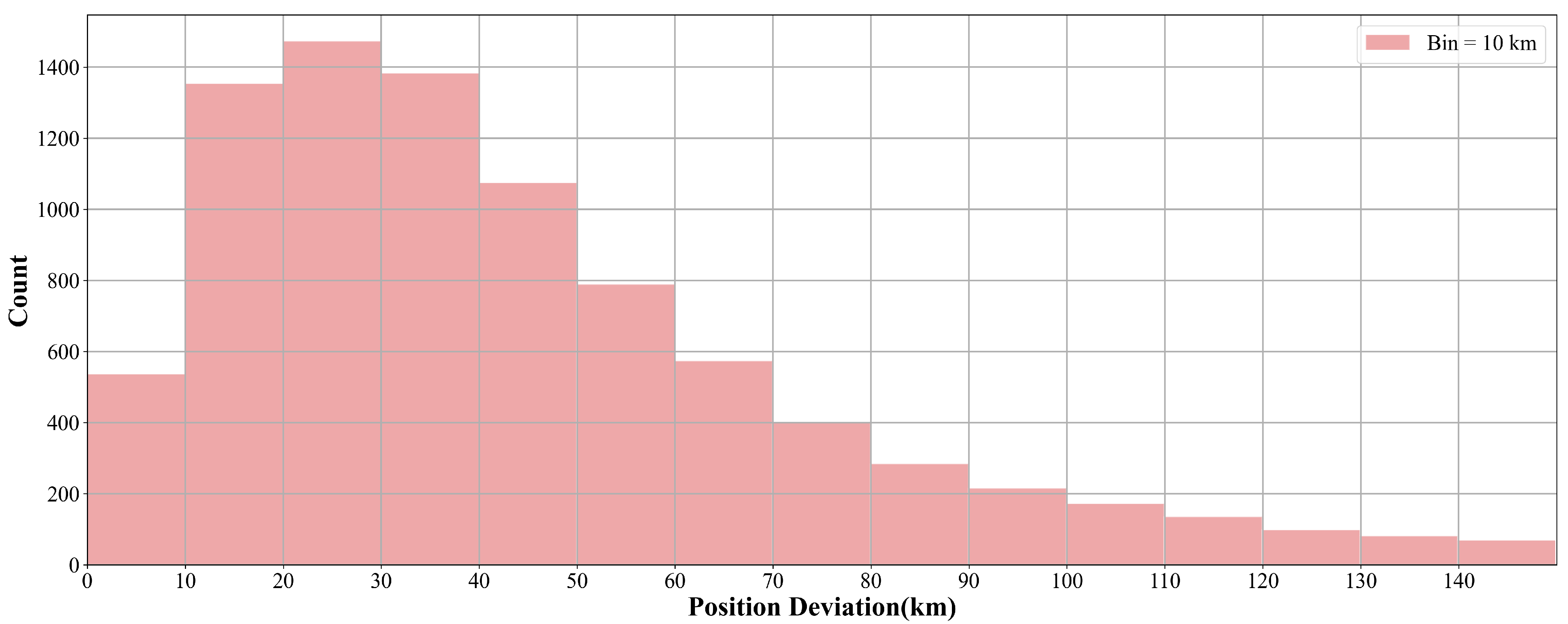

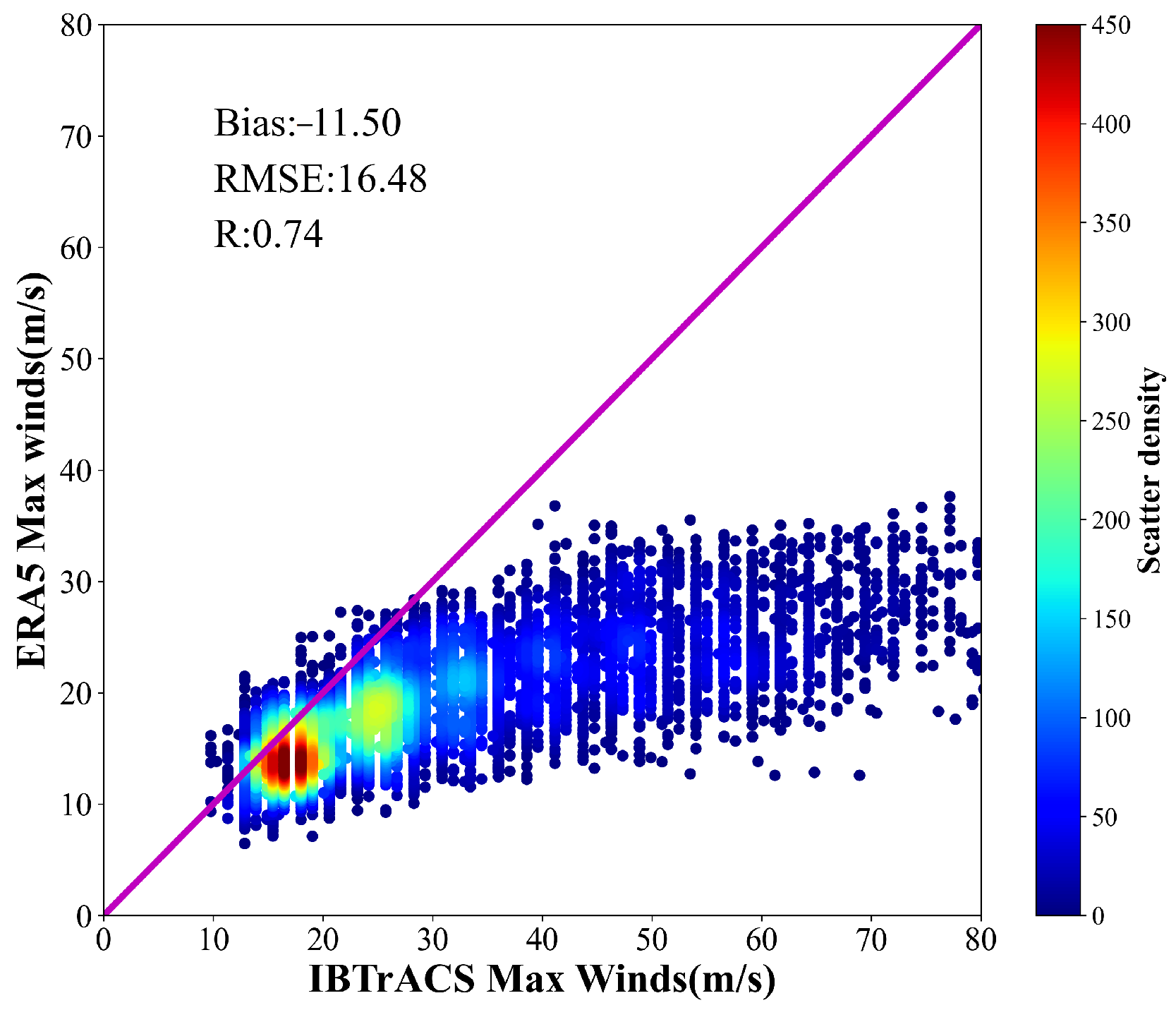
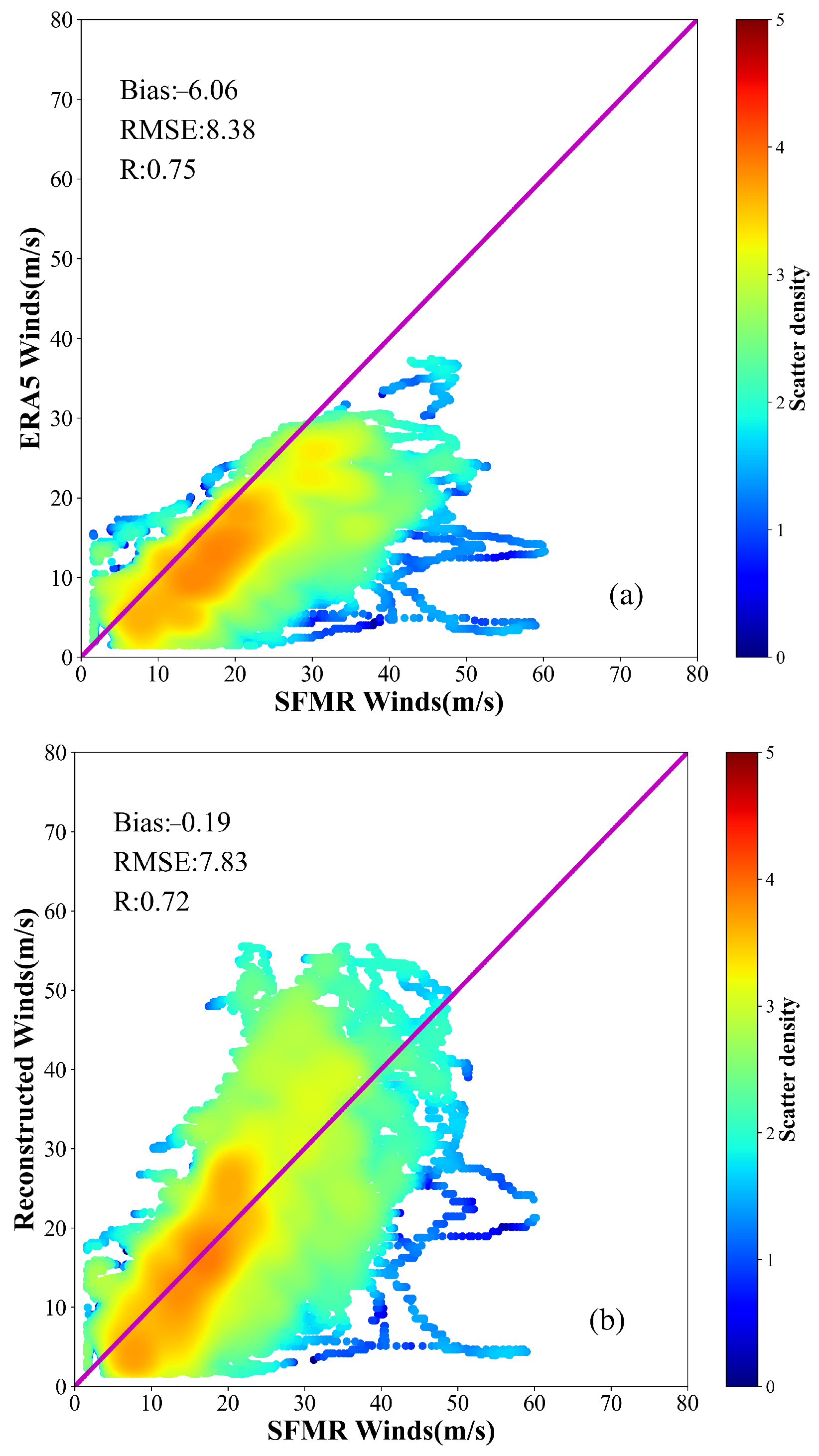
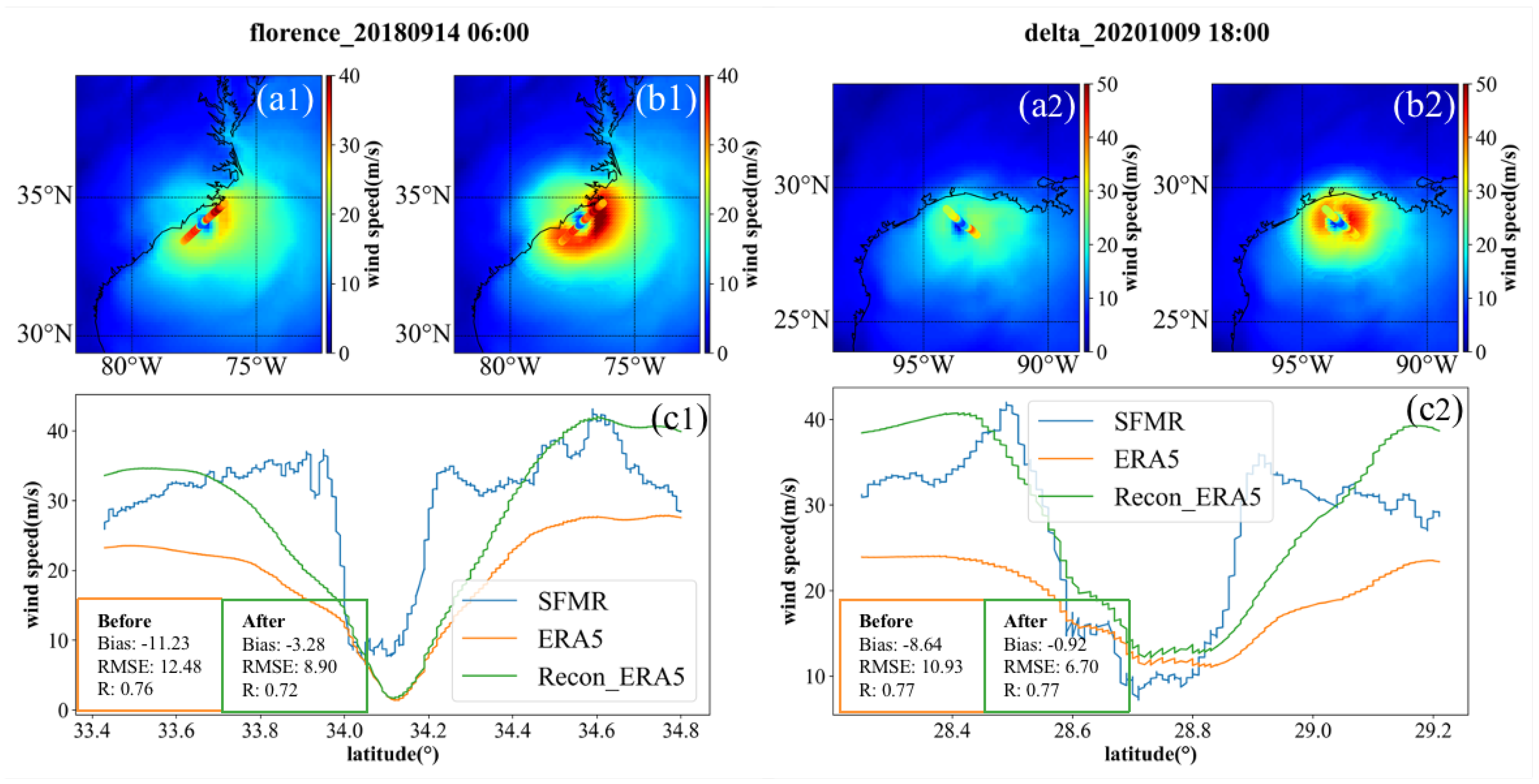

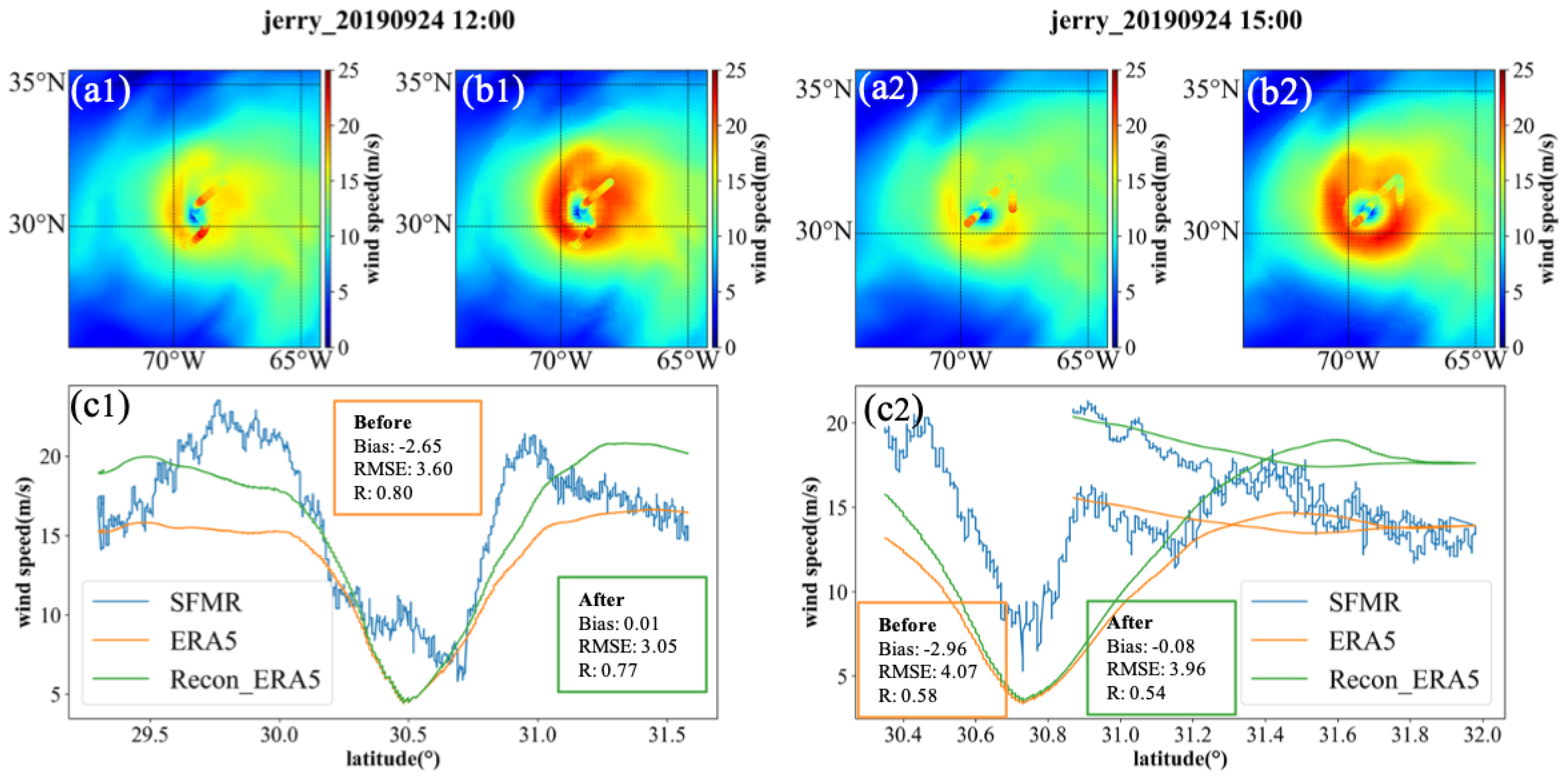
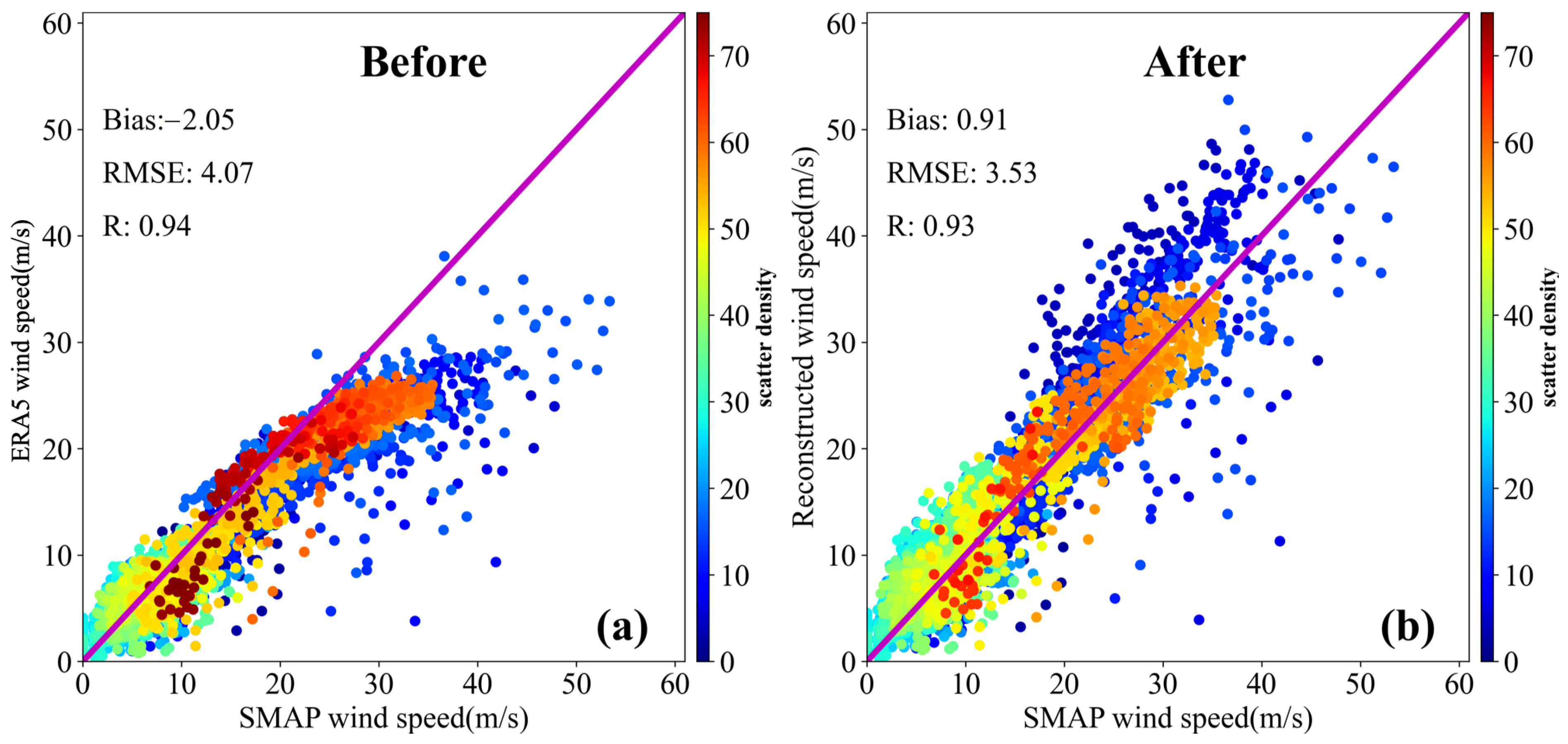

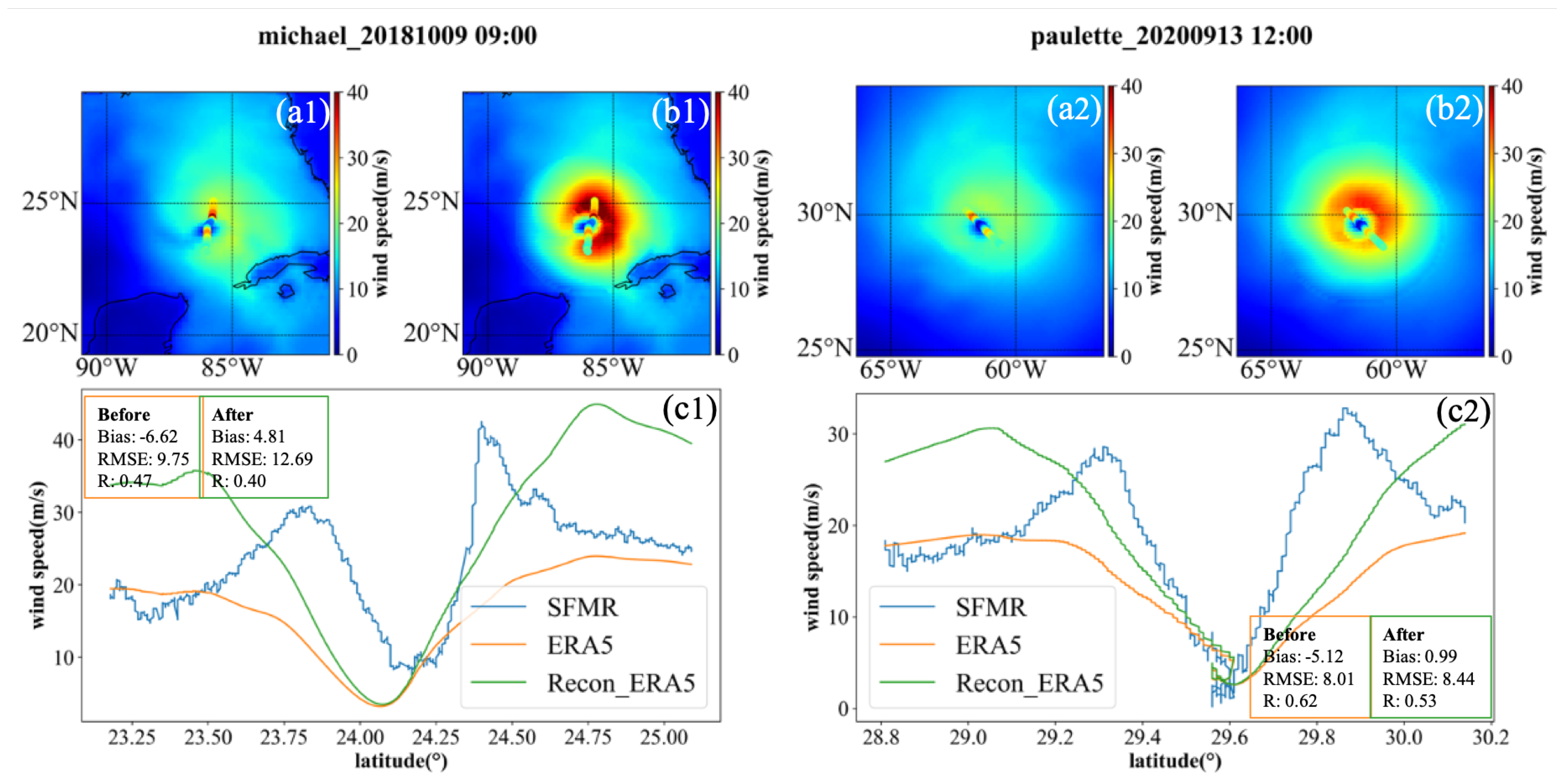
| Intensity | 1 Min Wind Speeds (Knots) | Flag |
|---|---|---|
| Tropical Depression | Wind < 34 | −1 |
| Tropical Storm | 34 < Wind < 64 | 0 |
| Category 1 | 64 ≤ Wind < 83 | 1 |
| Category 2 | 83 ≤ Wind < 96 | 2 |
| Category 3 | 96 ≤ Wind < 113 | 3 |
| Category 4 | 113 ≤ Wind < 137 | 4 |
| Category 5 | Wind ≥ 137 | 5 |
| Variable | Unit | Description |
|---|---|---|
| m/s | Reconstructed wind speed | |
| r | km | Distance from the tropical cyclone center |
| m/s | Background field from ERA5 | |
| m/s | Radius of the maximum wind speed | |
| ratio | – | Empirical parameter |
| Name | Reconstruction Time | Intensity | Name | Reconstruction Time | Intensity |
|---|---|---|---|---|---|
| Beryl | 20180708 12:00 | – | Lorenzo | 20190928 18:00 | Category 4 |
| Chris | 20180708 18:00 | Tropical storm | Nestor | 20191018 12:00 | – |
| Florence | 20180912 15:00 | Category 3 | Arthur | 20200518 12:00 | Tropical storm |
| Florence | 20180913 12:00 | Category 2 | Beta | 20200921 12:00 | Tropical storm |
| Florence | 20180913 21:00 | Category 2 | Beta | 20200921 15:00 | Tropical storm |
| Florence | 20180914 06:00 | Category 2 | Cristobal | 20200602 15:00 | Tropical storm |
| Florence | 20180914 09:00 | Category 1 | Cristobal | 20200603 12:00 | Tropical storm |
| Gordon | 20180904 18:00 | Tropical storm | Delta | 20201008 12:00 | Category 2 |
| Isaac | 20180912 15:00 | Tropical storm | Delta | 20201009 06:00 | Category 3 |
| Kirk | 20180926 15:00 | – | Delta | 20201009 15:00 | Category 2 |
| Kirk | 20180928 15:00 | Tropical storm | Delta | 20201009 18:00 | Category 2 |
| Michael | 20181008 06:00 | Tropical storm | Douglas | 20200725 18:00 | Category 2 |
| Michael | 20181008 12:00 | Category 1 | Douglas | 20200726 21:00 | Category 1 |
| Michael | 20181009 09:00 | Category 2 | Eta | 20201101 18:00 | Tropical storm |
| Olivia | 20180911 21:00 | Tropical storm | Eta | 20201109 15:00 | Tropical storm |
| Rosa | 20180930 18:00 | Category 1 | Gamma | 20201004 15:00 | Tropical storm |
| Barry | 20190711 09:00 | Tropical storm | Hanna | 20200724 15:00 | Tropical storm |
| Barry | 20190711 12:00 | Tropical storm | Hanna | 20200725 12:00 | Category 1 |
| Barry | 20190712 12:00 | Tropical storm | Hanna | 20200725 18:00 | Category 1 |
| Barry | 20190712 15:00 | Tropical storm | Isaias | 20200730 15:00 | Tropical storm |
| Barry | 20190712 18:00 | Tropical storm | Isaias | 20200731 06:00 | Category 1 |
| Barry | 20190713 15:00 | Category 1 | Isaias | 20200801 21:00 | Tropical storm |
| Dorian | 20190827 12:00 | Tropical storm | Isaias | 20200802 09:00 | Tropical storm |
| Dorian | 20190827 15:00 | Tropical storm | Isaias | 20200802 12:00 | Tropical storm |
| Dorian | 20190827 18:00 | Tropical storm | Isaias | 20200803 12:00 | Tropical storm |
| Dorian | 20190829 15:00 | Category 1 | Isaias | 20200803 15:00 | Tropical storm |
| Dorian | 20190831 15:00 | Category 4 | Laura | 20200824 12:00 | Tropical storm |
| Dorian | 20190902 21:00 | Category 4 | Laura | 20200825 12:00 | Category 1 |
| Dorian | 20190903 15:00 | Category 3 | Laura | 20200825 15:00 | Category 1 |
| Dorian | 20190904 09:00 | Category 2 | Paulette | 20200913 12:00 | Category 1 |
| Dorian | 20190904 18:00 | Category 2 | Sally | 20200912 18:00 | Tropical storm |
| Dorian | 20190904 21:00 | Category 3 | Sally | 20200913 12:00 | Tropical storm |
| Dorian | 20190905 18:00 | Category 2 | Sally | 20200913 15:00 | Tropical storm |
| Humberto | 20190914 12:00 | Tropical storm | Sally | 20200913 18:00 | Tropical storm |
| Humberto | 20190915 18:00 | Tropical storm | Sally | 20200915 06:00 | Category 1 |
| Humberto | 20190916 12:00 | Category 1 | Sally | 20200915 15:00 | Category 1 |
| Humberto | 20190918 12:00 | Category 1 | Sally | 20200915 18:00 | Category 1 |
| Ivo | 20190824 21:00 | Tropical storm | Sally | 20200916 09:00 | Category 2 |
| Jerry | 20190920 15:00 | Category 1 | Teddy | 20200917 15:00 | Category 3 |
| Jerry | 20190921 03:00 | Tropical storm | Teddy | 20200921 12:00 | Category 1 |
| Jerry | 20190921 12:00 | Tropical storm | Teddy | 20200922 15:00 | Category 2 |
| Jerry | 20190923 12:00 | Tropical storm | Teddy | 20200922 21:00 | Category 1 |
| Jerry | 20190924 12:00 | Tropical storm | Zeta | 20201025 06:00 | Tropical storm |
| Jerry | 20190924 15:00 | Tropical storm | Zeta | 20201025 21:00 | Tropical storm |
| Karen | 20190923 12:00 | Tropical depression | Zeta | 20201026 06:00 | Category 1 |
| Karen | 20190924 15:00 | Tropical storm | Zeta | 20201026 18:00 | Category 1 |
| Karen | 20190925 18:00 | Tropical storm | Zeta | 20201028 21:00 | Category 3 |
Publisher’s Note: MDPI stays neutral with regard to jurisdictional claims in published maps and institutional affiliations. |
© 2022 by the authors. Licensee MDPI, Basel, Switzerland. This article is an open access article distributed under the terms and conditions of the Creative Commons Attribution (CC BY) license (https://creativecommons.org/licenses/by/4.0/).
Share and Cite
Li, X.; Yang, J.; Han, G.; Ren, L.; Zheng, G.; Chen, P.; Zhang, H. Tropical Cyclone Wind Field Reconstruction and Validation Using Measurements from SFMR and SMAP Radiometer. Remote Sens. 2022, 14, 3929. https://doi.org/10.3390/rs14163929
Li X, Yang J, Han G, Ren L, Zheng G, Chen P, Zhang H. Tropical Cyclone Wind Field Reconstruction and Validation Using Measurements from SFMR and SMAP Radiometer. Remote Sensing. 2022; 14(16):3929. https://doi.org/10.3390/rs14163929
Chicago/Turabian StyleLi, Xiaohui, Jingsong Yang, Guoqi Han, Lin Ren, Gang Zheng, Peng Chen, and Han Zhang. 2022. "Tropical Cyclone Wind Field Reconstruction and Validation Using Measurements from SFMR and SMAP Radiometer" Remote Sensing 14, no. 16: 3929. https://doi.org/10.3390/rs14163929
APA StyleLi, X., Yang, J., Han, G., Ren, L., Zheng, G., Chen, P., & Zhang, H. (2022). Tropical Cyclone Wind Field Reconstruction and Validation Using Measurements from SFMR and SMAP Radiometer. Remote Sensing, 14(16), 3929. https://doi.org/10.3390/rs14163929







